Hit the mat, fellas.
To say that men’s wrestling is an exciting sport isn’t exactly revolutionary. Think about it; two men wearing tight-fitting uniforms made of spandex roll on top of each other in an attempt to top and pin their opponent. A quick Google image search of the words “wrestling” and “hot” will turn up thousands of pictures that are … exciting … despite their manly framework of the sport.
Related | 29 Slick Pics of Greasy Guys Oil Wrestling in Turkey
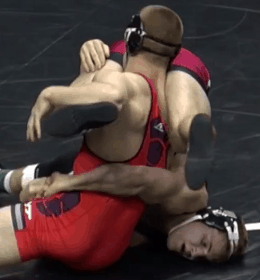
Wrestling, at its core, is a sport defined by strength, technique, and agility. Yet, for anyone who’s spent time watching men’s collegiate matches, it’s clear that it transcends mere displays of power and speed. It often becomes a charged spectacle where every movement, from a lightning-quick takedown to a slow, grinding hold, contributes to a narrative that’s both fiercely competitive and subtly intimate.
Layer in the tight-fitting singlets and the roar of the crowd, and wrestling takes on an entirely new dimension—one that blurs the line between respectable sport and something more provocative. The friction of muscle against muscle, the sweat-drenched effort to dominate, and the razor-sharp focus on body positioning all blend into a performance that can feel as sensual as it is athletic. In that heated mixture, boundaries blur, making the experience as visually arresting as it is physically grueling.
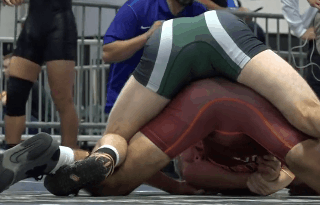
When two wrestlers face off, the intensity crackling between them is almost palpable. Eyes lock, muscles tense, and both competitors mentally prepare for a battle of leverage and will. It’s this heightened tension that turns an ordinary gymnasium into an arena of psychological warfare, as each grappler tests the other’s resilience and adaptability.
Underneath that tension lies a current of physical dialogue that transcends words. The wrestlers communicate through shifts in weight, subtle changes in stance, and the controlled violence of their holds. In this language of limbs and torsos, there’s an unspoken understanding: each participant must come to terms with the paradox of seeking both control and freedom within another person’s grasp.
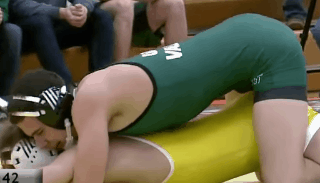
The “grabbiness” of wrestling may surprise newcomers, but for seasoned fans, it’s a defining feature of the sport’s raw authenticity. Hands inevitably find their way to unexpected places as competitors scramble to gain position, exploit a weak angle, or secure a decisive grip. This close-quarters battle ensures that no part of the body is off-limits to becoming leverage in the quest for dominance.
These accidental or strategic touches are rarely meant to be provocative; rather, they’re a natural consequence of grappling in tight quarters. Yet to the outside observer, such contact can seem startlingly personal. Just as a painter’s brush strokes reveal the contours of a landscape, a wrestler’s hand placements reveal the merciless topography of human vulnerability.
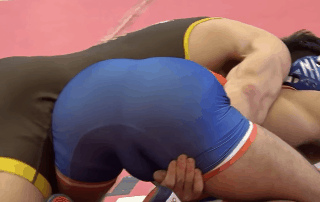
Awkwardness is inevitable in a sport where bodies collide so forcefully and frequently. Wrestlers learn early on that embarrassment has no place on the mat; once the whistle blows, every second matters, and the last thing on their minds is the social etiquette of hand placement. This unapologetic physicality demands an ironclad focus on winning and nothing more.
The absence of hesitation or shame in these moments isn’t a lack of sensitivity, but a byproduct of intense concentration. Wrestlers train rigorously to treat every inch of their opponent’s body as potential territory for securing an advantage. If a hand strays into sensitive territory, it’s just another fleeting second in the relentless pursuit of victory—an event so common it barely merits a flinch among seasoned athletes.
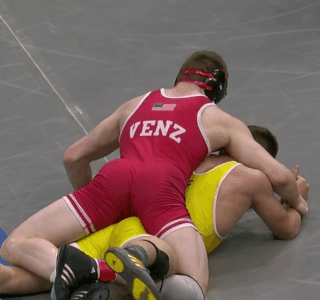
For the spectator, these fleeting, provocative touches—frozen and looped in GIF form—can assume a life of their own. When slowed down and isolated, what was once a split-second, utilitarian maneuver becomes an endlessly replayed moment of intrigue. Online, these snippets can provoke a range of responses: laughter, discomfort, curiosity, or even admiration.
The digital realm amplifies the shock and humor of these incidents, transforming a private athletic struggle into public spectacle. Fans and casual viewers alike dissect these GIFs, hypothesizing the wrestlers’ intentions and reveling in the awkwardness. Such scrutiny reminds us that in the age of pervasive media, nothing stays confined to the mat; every moment has the potential to become a viral talking point.
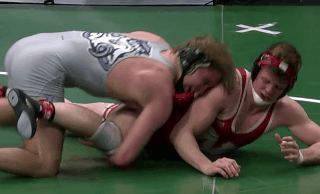
The truth is, wrestlers don’t set out to create these intimate-looking moments. Every hold, grasp, and maneuver is in service of securing points, gaining positional advantage, or wearing down an opponent’s defenses. Their minds are locked on strategy, breathing technique, and muscle memory, not on any subtext people might read into their movements.
Yet, from the outside looking in, the body language of wrestling can be interpreted in countless ways. When raw athleticism meets the human tendency to find narrative and meaning in physical contact, misunderstandings are inevitable. Observers might see eroticism, humor, or discomfort, all stemming from the simplest of athlete-to-athlete interactions.
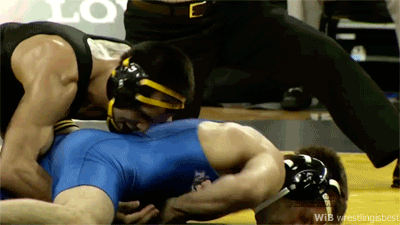
At the collegiate level, wrestling demands a mastery of fundamental techniques that require extreme precision. Athletes train tirelessly to learn how to control an opponent’s limbs, shift their balance, and anticipate their next move. This rigorous skill set underpins every awkward moment that might appear on a highlight reel—or a GIF—later on.
Beyond technique, the sport calls for remarkable adaptability. Each match is a live puzzle, solved by experimentation under physical duress. In executing these maneuvers, wrestlers embrace uncertainty, sometimes finding their hands or faces pressed against unfamiliar terrain. Such closeness is less a conscious choice than a natural outcome of bodies straining at their limits.
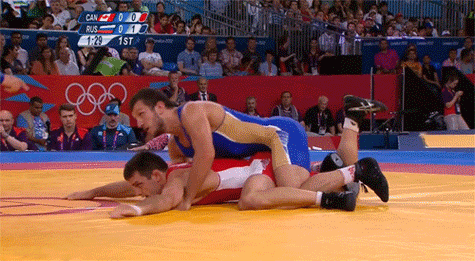
Physiological responses, like arousal, can occur spontaneously when two bodies are locked in fierce contact. It’s an uncomfortable subject for many, but it’s a simple biological possibility. The flood of adrenaline, intense friction, and hormonal surges can occasionally trigger unexpected reactions.
For wrestlers, this is another mental hurdle. They learn to keep calm and carry on, focusing on the match rather than any involuntary bodily responses. Onlookers, however, might find such revelations intriguing or perplexing, pondering the interplay between primal instincts and disciplined athletic performance.

These moments of involuntary arousal rarely define a match, but when captured, they become part of the tapestry of wrestling lore. Competitors know they must maintain composure and not allow any transient distraction to undermine their game. The whistle’s shrill command keeps them in the realm of strategy and determination.
Meanwhile, in the stands or online, whispers and chuckles may emerge if someone notices what appears to be a telltale sign of excitement. In a world where every pixel is examined, one can’t always control the narrative. Yet wrestlers continue to grapple with unwavering focus, aware that their fleeting bodily responses are just that—fleeting and ultimately inconsequential.
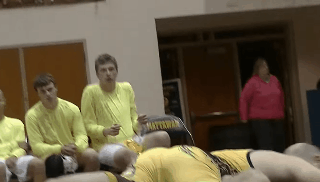
Wrestling’s fan base is diverse, ranging from die-hard purists who admire the sport’s intricacies to casual viewers drawn in by the spectacle. Some come for the technique, reveling in the mastery of leverage and angles. Others are drawn by the raw physicality and underlying erotic charge that occasionally surfaces.
This collision of interests makes the sport a cultural magnet. It prompts conversations about masculinity, athleticism, and the thin lines that separate competition, entertainment, and sensuality. Each fan brings their own biases and curiosities, forging a dynamic discourse around the multifaceted allure of wrestling.
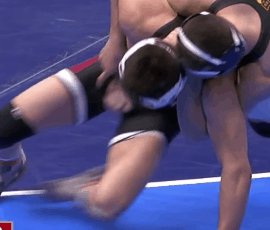
Wrestling’s fan base is diverse, ranging from die-hard purists who admire the sport’s intricacies to casual viewers drawn in by the spectacle. Some come for the technique, reveling in the mastery of leverage and angles. Others are drawn by the raw physicality and underlying erotic charge that occasionally surfaces.
This collision of interests makes the sport a cultural magnet. It prompts conversations about masculinity, athleticism, and the thin lines that separate competition, entertainment, and sensuality. Each fan brings their own biases and curiosities, forging a dynamic discourse around the multifaceted allure of wrestling.
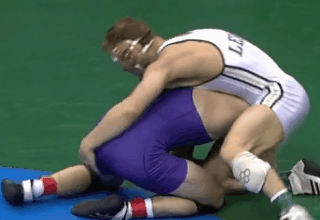
Wrestling’s inherently intimate nature stems from its closeness. Athletes spend entire matches pressed against one another, each working to neutralize the other’s power. It’s a paradoxical blend of confrontation and closeness, as their bodies must align for one to claim the upper hand.
Within these contortions, there’s a certain vulnerability. Wrestlers can feel their opponent’s heartbeat, sense their breathing patterns, and detect subtle shifts in muscle tension. These micro-detections inform strategy, but also underscore the physical intimacy that—even if unintended—exists within the struggle for supremacy.

While accidental grabs and intimate contact might garner attention, wrestlers are bound by rules and a code of conduct. Unsportsmanlike behavior can lead to penalties or disqualification. Most competitors respect these boundaries, knowing that their reputation depends on fairness and skill, not cheap shots.
Still, accidents do happen. A hand slips, a leg jerks, and suddenly, a moment is born that spectators replay for laughter or disbelief. Wrestlers accept this as occupational hazard. For them, the focus always returns to technique, form, and executing the perfect move to secure a victory.
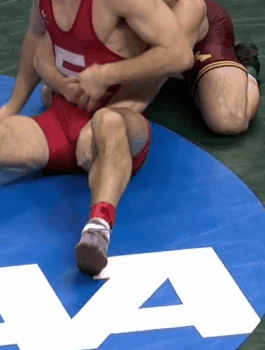
The absurdity of certain captured moments reminds us that, as disciplined as the sport is, it can’t escape the occasional lapse into comedic territory. When slowed down to a GIF’s repetitive loop, even the most technical maneuver can appear slapstick, drawing out laughter that coexists with admiration.
This comedic factor doesn’t diminish wrestling’s competitive integrity. Instead, it highlights that behind every serious match are human beings susceptible to slips, hiccups, and unexpected bodily alignments. In that vulnerability, fans find reasons to smile, humanizing the athletes who strive to remain stoic and controlled.

The tension between sincerity and humor shapes our perception of these moments. We know that wrestlers train relentlessly and carry immense pride in their craft. Yet, a single GIF can momentarily overshadow their dedication, transforming them into reluctant comedians in a looped snippet of awkward contact.
By embracing these contradictions, we acknowledge the complexity of sports. Wrestling can be both noble and ridiculous, dignified and goofy. Its layered nature allows fans to appreciate the athleticism while also acknowledging the unexpected humanity that emerges in sudden, unscripted intervals.
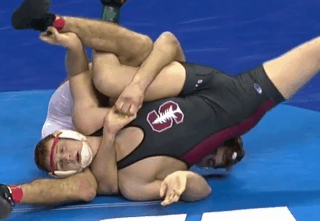
Within these 35 GIFs, you might see a wrestler executing a flawless maneuver that, frozen in time, appears strangely suggestive. Another clip might capture a startled facial expression following a misplaced hand. Each one is a tiny window into the unpredictable realities of a high-contact competition.
Rather than dismissing these moments as mere accidents, we can view them as snapshots of authenticity. They reveal truths about wrestling that a highlight reel of smooth takedowns might never convey. Namely, that even the most skilled athletes find themselves tangled in situations that leave them—and us—surprised and amused.

Sometimes, these GIFs showcase the aftermath: a wrestler adjusting his singlet, shooting a confused glance at the referee, or pausing as if to confirm what just happened. These subtle reactions add a narrative layer, hinting at the inner thoughts that the audience can only guess.
Such glimpses into post-contact reactions remind us that wrestlers aren’t automatons. They possess emotional depth and personal boundaries, even if those boundaries must be momentarily shelved during competition. In that interplay of stoicism and surprise, we glimpse the true complexity of athletic psychology.
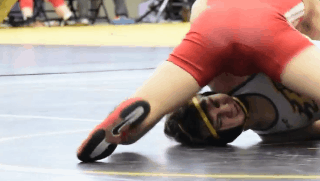
Not every wrestling match features these eyebrow-raising moments. Many bouts proceed with seamless precision, each technique executed flawlessly. Yet, we rarely celebrate the matches that lack drama or awkwardness with the same fervor as those that yield memorable GIF-worthy incidents.
Perhaps this reflects a broader human tendency: we gravitate toward the unexpected and the humorous, even in spheres where discipline and seriousness reign. The more straightforward contests impress the connoisseurs of technique, but it’s the odd misplacement of a hand that sparks viral interest, reminding us that unpredictability fuels our fascination.
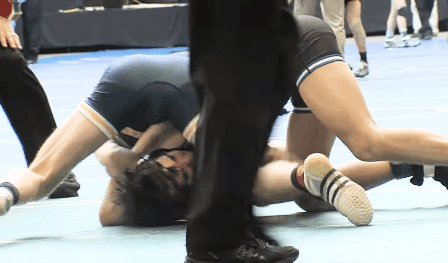
Wrestling’s hypermasculine image collides with these intimate mishaps in a way that can feel startling. The sport is framed as a proving ground of strength and toughness, yet these awkward moments expose softer, more vulnerable facets of male bonding—albeit unintended and fleeting.
This paradox invites reflection on the nature of masculinity and athletic identity. Within the ring, physical dominance coexists with uncomfortable intimacy, challenging traditional notions of what it means to be strong, stoic, and unyielding. It’s precisely this layered complexity that keeps fans and newcomers fascinated.
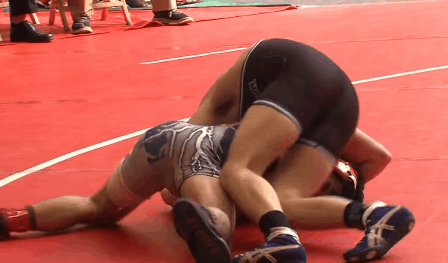
For those unfamiliar with wrestling’s intensity, the idea that two athletes would willingly enter such tight quarters can seem perplexing. Yet, personal space is a luxury that wrestlers happily relinquish in pursuit of victory. Their comfort zone shrinks to the dimensions of another human’s body, redefined by the necessity of physical engagement.
In embracing this closeness, wrestlers become fluent in the language of contact. They learn to navigate each other’s strengths and weaknesses through touch rather than speech. It’s an intimacy born not of affection, but of competition, an understanding forged by the ceaseless interplay of force and resistance.
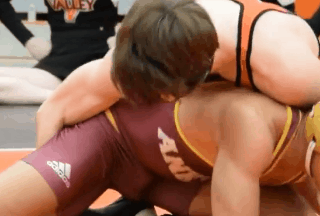
The mesmerizing power of these GIFs lies in their ability to reveal how wrestling unfolds at a fundamental level. It’s a story told through tension and release, through bodies pressed together at improbable angles, every muscle working in concert to gain an inch of advantage.
Such imagery reminds us that wrestling isn’t just about the scoreboard or the final whistle. It’s about the countless micro-moments in between—those raw, unscripted instances where nature and human effort intersect. The beauty and absurdity of these moments are what give the sport its unique texture.

Consider the plight of a college wrestler who discovers a GIF of himself accidentally grabbing his opponent’s crotch. It’s not exactly the highlight he dreamed of when he began training. Yet, in the modern era, any captured frame can break free from context and circle the globe in seconds.
This digital permanence forces athletes to confront their own image in ways previous generations never did. Embarrassment, humor, and resignation might all blend together as they realize their legacy now includes a moment they wish had gone unnoticed. Still, the next match beckons, offering a chance to replace viral oddity with athletic prowess.
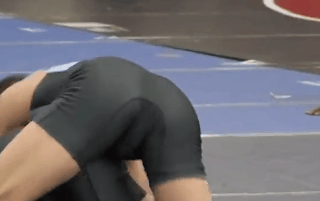
For fans, these awkward GIFs are like Easter eggs hidden within the larger tapestry of the sport. They offer a break from the solemnity of competition, reminding us that even the most disciplined athletes are subject to the peculiarities of human interaction.
Such moments become shared jokes, points of conversation, and insights into the unpredictable nature of real-life encounters. They affirm that wrestling, for all its seriousness and skill, is still governed by chance, gravity, and the whims of two bodies colliding under stress.
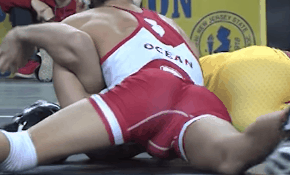
Sports are about more than just the outcome; they encompass the stories that unfold before, during, and after the match. Awkward grabs and strange facial expressions add dimension to these narratives. They become talking points, the details that define a match’s personality.
By acknowledging these oddities, we celebrate sport as an arena of human complexity rather than a sanitized showcase of skill. The journey includes mishaps, misunderstandings, and moments that defy neat categorization. In embracing them, we gain a fuller understanding of what it means to compete.
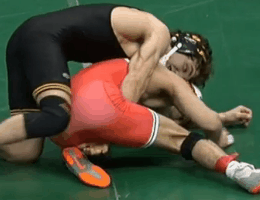
Like ballet, wrestling highlights the body’s capacity for expression through movement. Yet unlike ballet’s graceful arcs, wrestling’s motions are often harsh and driven by competitive urgency. This contrast heightens the drama and potential for the unexpected.
In those moments where a body part lands in a questionable place, we see a jarring intersection of beauty and awkwardness. Both extremes coexist in the same mat space, revealing that human bodies, even in pursuit of victory, resist neat labels. Through wrestling, we experience a form of art defined by struggle and surprise.
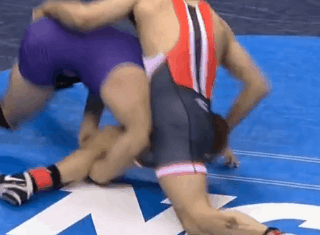
The potential eroticism within wrestling is an undercurrent seldom discussed openly. Yet, where there is close bodily contact, sweat, and friction, desire can emerge unbidden. It’s not something wrestlers seek out, but neither can it be entirely denied.
This undercurrent complicates how we view the sport. Is it purely about winning, or does it also blur into realms of physical pleasure, tension, and the gravitational pull of flesh against flesh? Wrestling’s layered nature ensures that no single interpretation can fully capture its complexity.
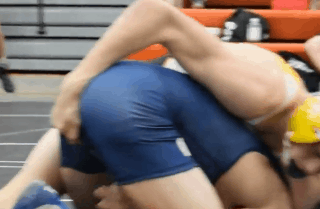
Society often grapples with the idea of male intimacy, still shackled by stereotypes and archaic notions of masculinity. Wrestling’s intense physical proximity challenges these constructs, defying expectations of how men should interact, touch, or respond to each other’s bodies.
In doing so, the sport becomes a quiet revolution, normalizing the idea that strength and closeness are not mutually exclusive. It suggests that male athletes can engage in deeply physical acts without forfeiting their dignity or sense of self. The GIFs merely document the reality that such intimacy is part and parcel of this demanding discipline.
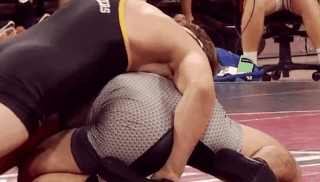
The GIFs we highlight invite viewers to reassess their assumptions. Instead of seeing wrestling as a straightforward contest of brute force, these captured moments encourage a more nuanced perspective. They acknowledge that awkwardness, humor, and even embarrassment are integral components of the athletic experience.
In recognizing this, we expand our understanding of sports. We learn that athletes, regardless of their prowess, remain human—susceptible to chance and the occasional inappropriate grip. This broadened view allows for empathy and appreciation, transforming spectators into more discerning and compassionate observers.
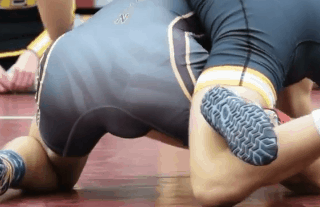
The significance of these GIFs lies not in the momentary grip itself, but in the conversations they spark. They lead us to question notions of propriety, masculinity, and the visibility of intimate moments in competitive spaces. Without the internet and its magnifying lens, these topics might remain largely unexplored.
Each shared clip fosters dialogue, bringing people together to laugh, debate, and reflect. In doing so, the digital circulation of such awkward encounters enriches cultural discourse, ultimately reminding us that physical encounters—even accidental ones—carry meaning far beyond the mat.
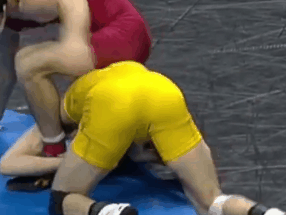
Wrestlers themselves might be mortified that a stray hand placement becomes internet fodder. Yet, this candid spotlight reveals a side of the sport that polished highlight reels never show. When you witness the humanizing flaws and honest mistakes, you realize that athletes aren’t immune to awkwardness.
Instead of eroding respect, these moments often amplify it. The audience sees not just a grappler, but a person juggling discipline, desire, adrenaline, and environment. This more textured view can deepen admiration for the sheer composure required to remain focused under such complex conditions.
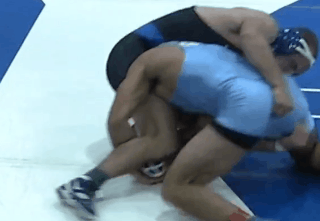
After watching these GIFs, it’s hard not to marvel at the delicate balance wrestlers maintain. They must be warriors and tacticians, pushing bodies to extremes while ignoring the clumsy intrusions of chance. It’s a tightrope walk that requires both mental fortitude and physical grace.
If we allow ourselves to see the humor and humanity behind the spectacle, we gain a richer appreciation for wrestling’s intricate layers. The sport’s grabby moments aren’t a detour from the narrative; they’re part of its ongoing story, reminding us that within the struggle for domination, the unexpected always awaits.
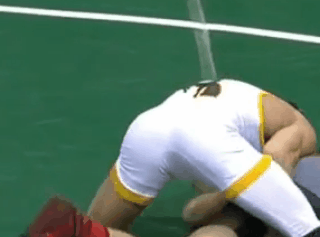
The complexity of male athletic relationships unfolds at close range in wrestling. There’s trust in how far each competitor can push without breaking the other’s body. There’s respect in acknowledging that both are submitting to a raw, primal form of competition.
Yet, this closeness also shatters illusions of personal space. It prompts athletes and viewers alike to contemplate the boundaries between combat and camaraderie. In the midst of grappling, wrestlers share an intimacy that, while born of struggle, reveals something profound about human connection.
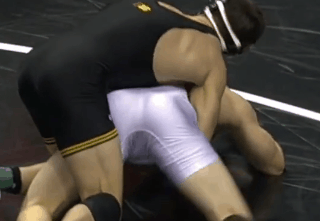
These 35 GIFs underscore that sports are populated by real people, not polished avatars of perfection. Wrestlers sweat, strain, and sometimes stumble into laughably awkward predicaments. They must accept that public scrutiny comes with the territory.
This very acceptance is what makes their achievements more genuine. Knowing that a single moment of clumsy contact might live online forever, they still put their reputations on the line to compete. Their willingness to face both triumph and embarrassment only amplifies our admiration for their dedication.
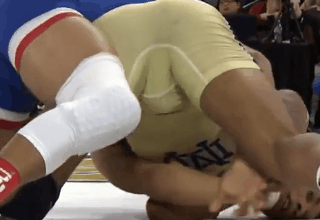
Context is key. A clip that looks absurd in isolation might have been one second within a hard-fought, grueling match. Understanding the skill, courage, and stamina required puts these awkward moments into perspective, grounding them in the reality of athletic struggle.
Over time, such snippets become part of the collective memory of wrestling culture. They serve as reminders that even the most disciplined endeavors encounter unpredictability. In that sense, these images of accidental intimacy become affectionate footnotes in the broader narrative of the sport.
Ultimately, wrestling’s grabby nature and occasional awkwardness don’t diminish its legitimacy as a competitive discipline. Instead, they layer the sport with intrigue, offering spectators a chance to see something raw and unfiltered. These incidents highlight that perfection, while admirable, is never the whole story.
In acknowledging the unexpected arousals, misplaced hands, and uncomfortable glances, we accept wrestling in its entirety—unvarnished, unpredictable, and utterly human. Within these tangled limbs and fleeting gestures, we find an arena where strength and vulnerability collide, reminding us why this centuries-old sport continues to captivate and astonish.







